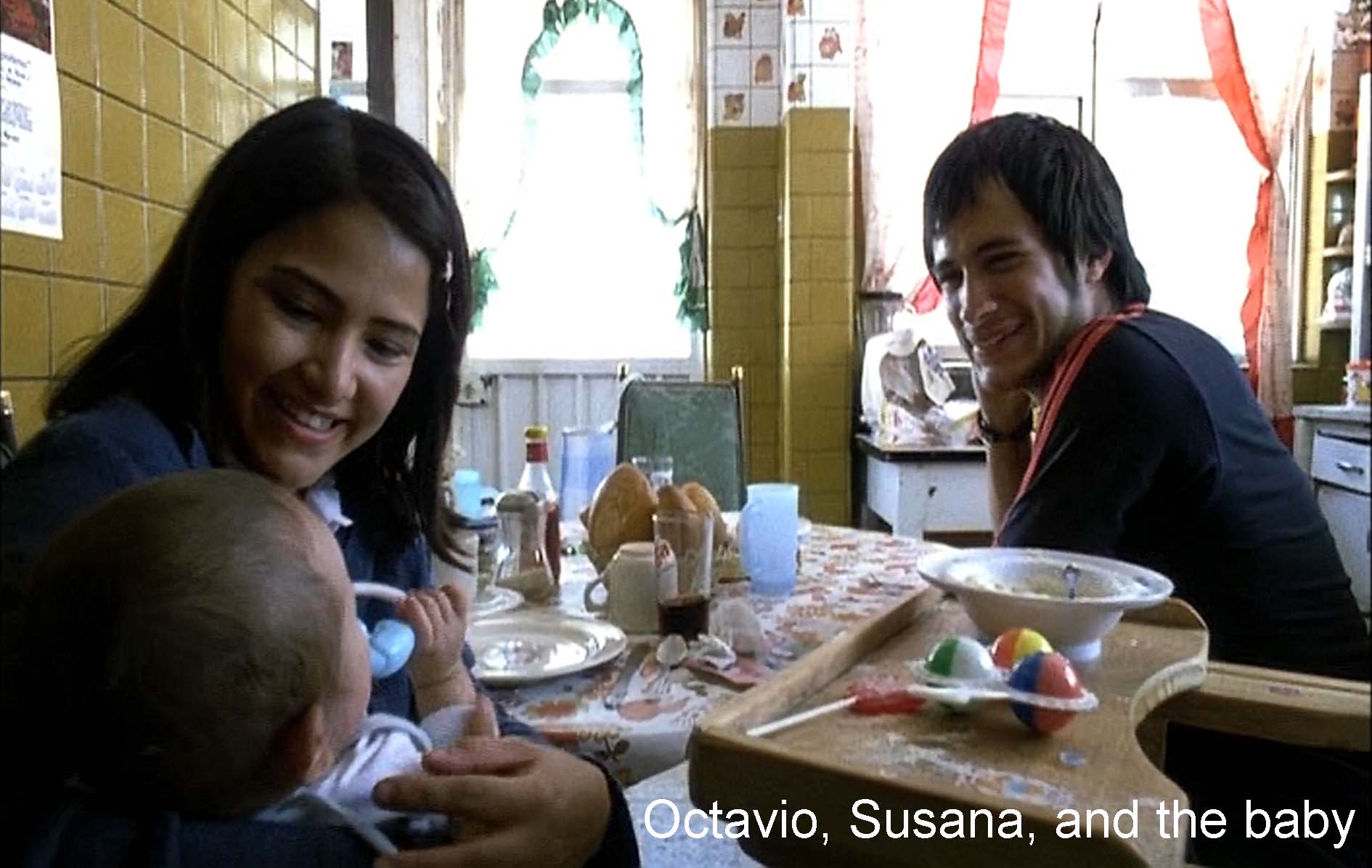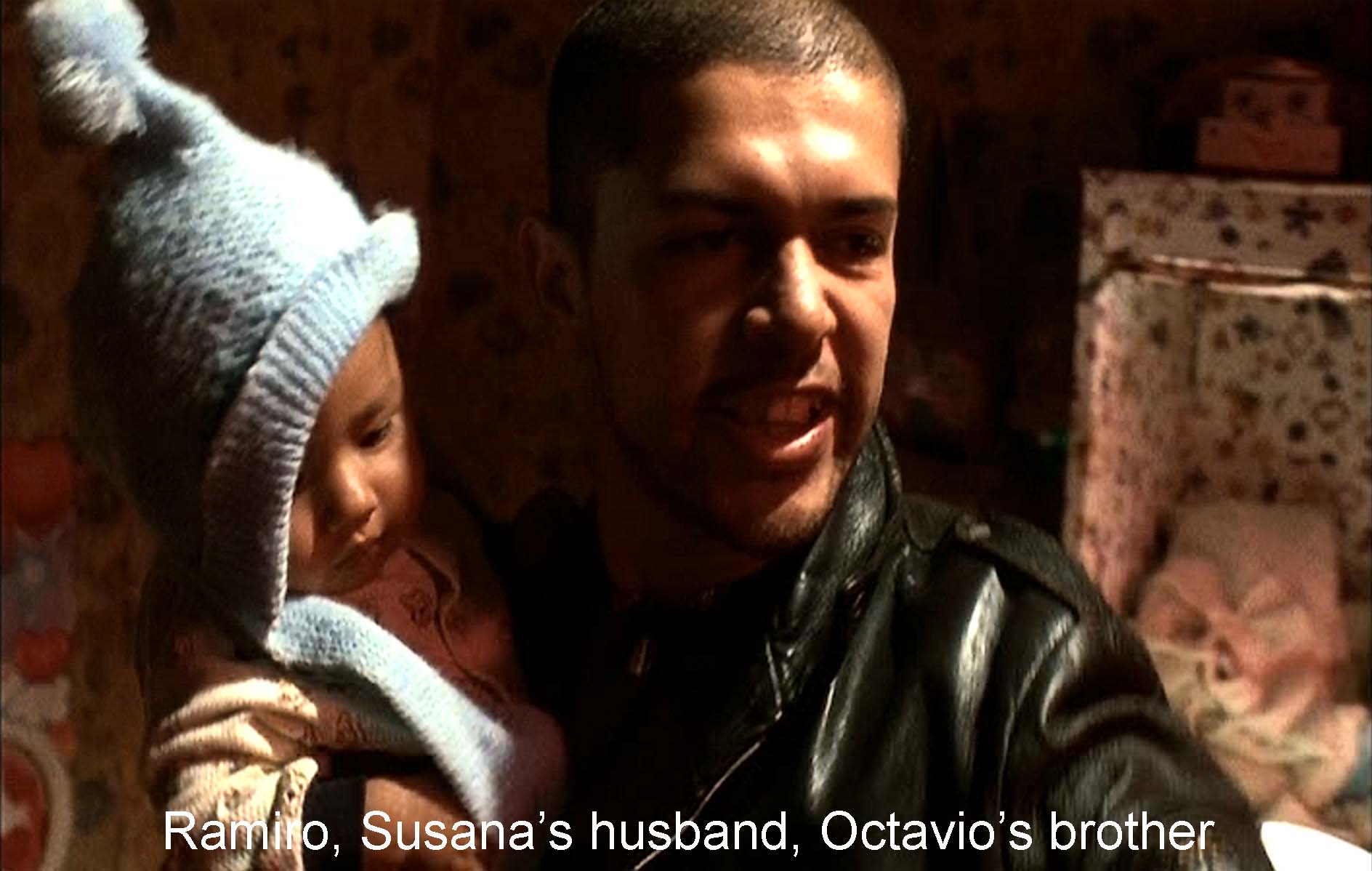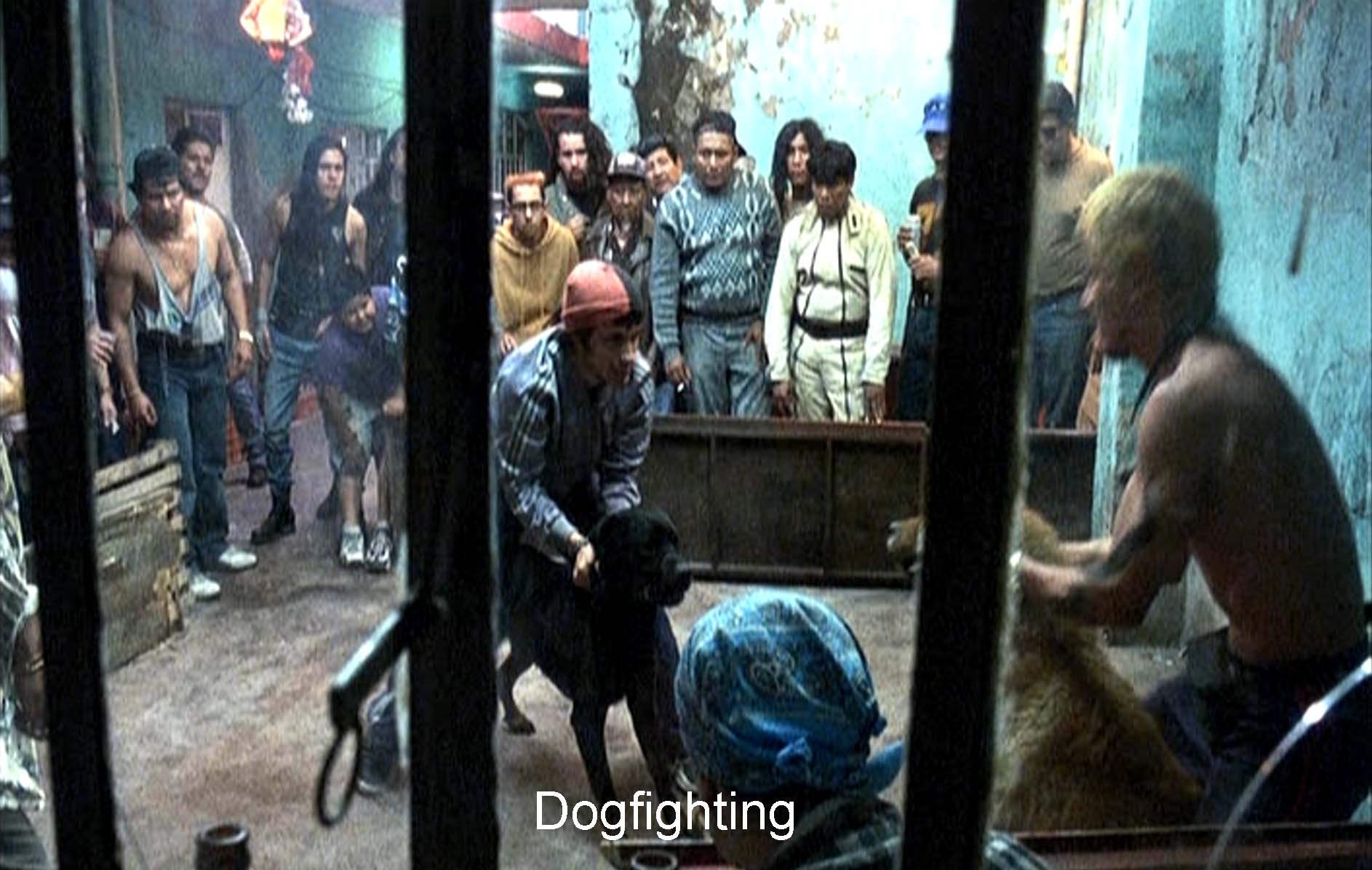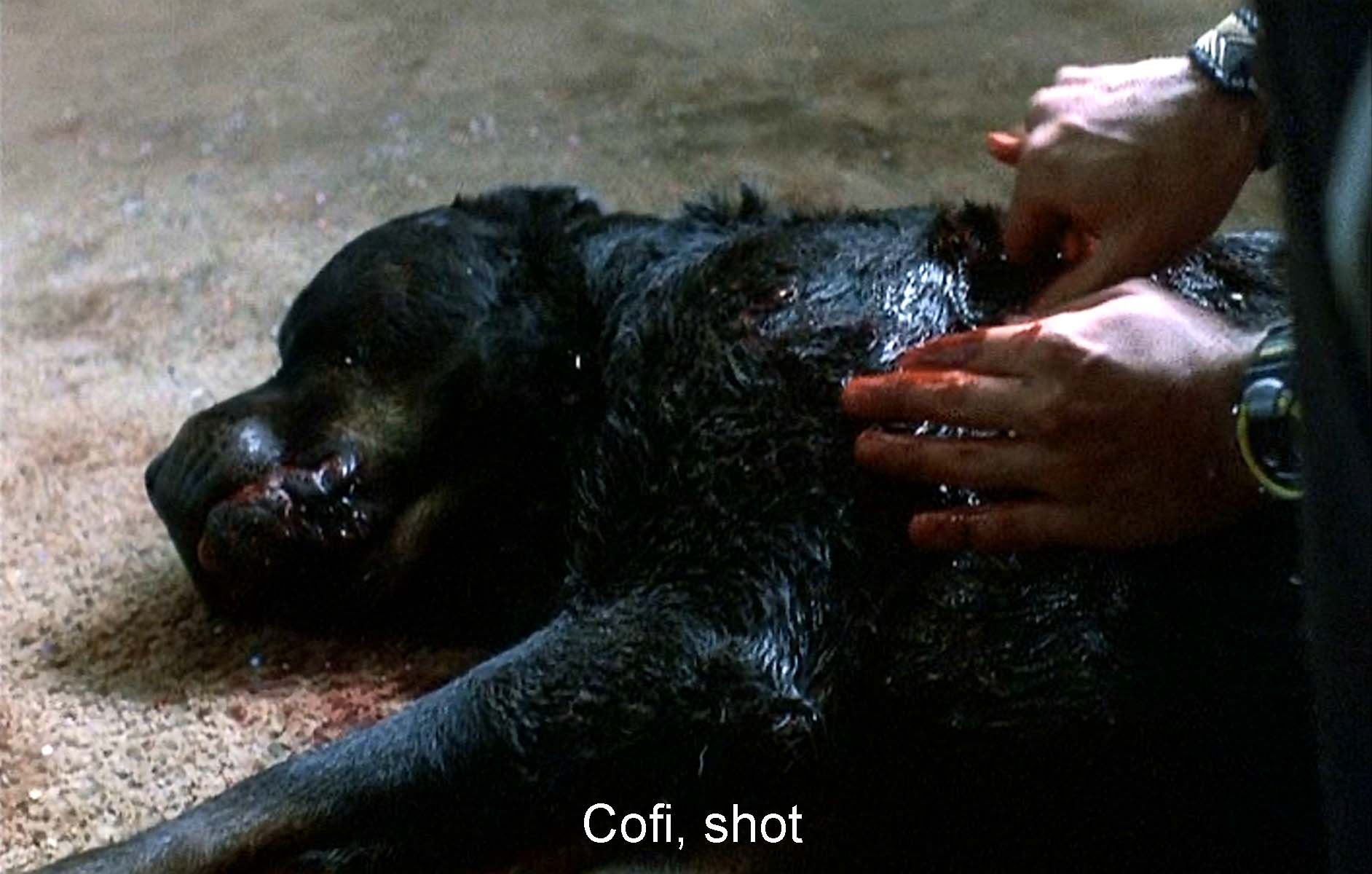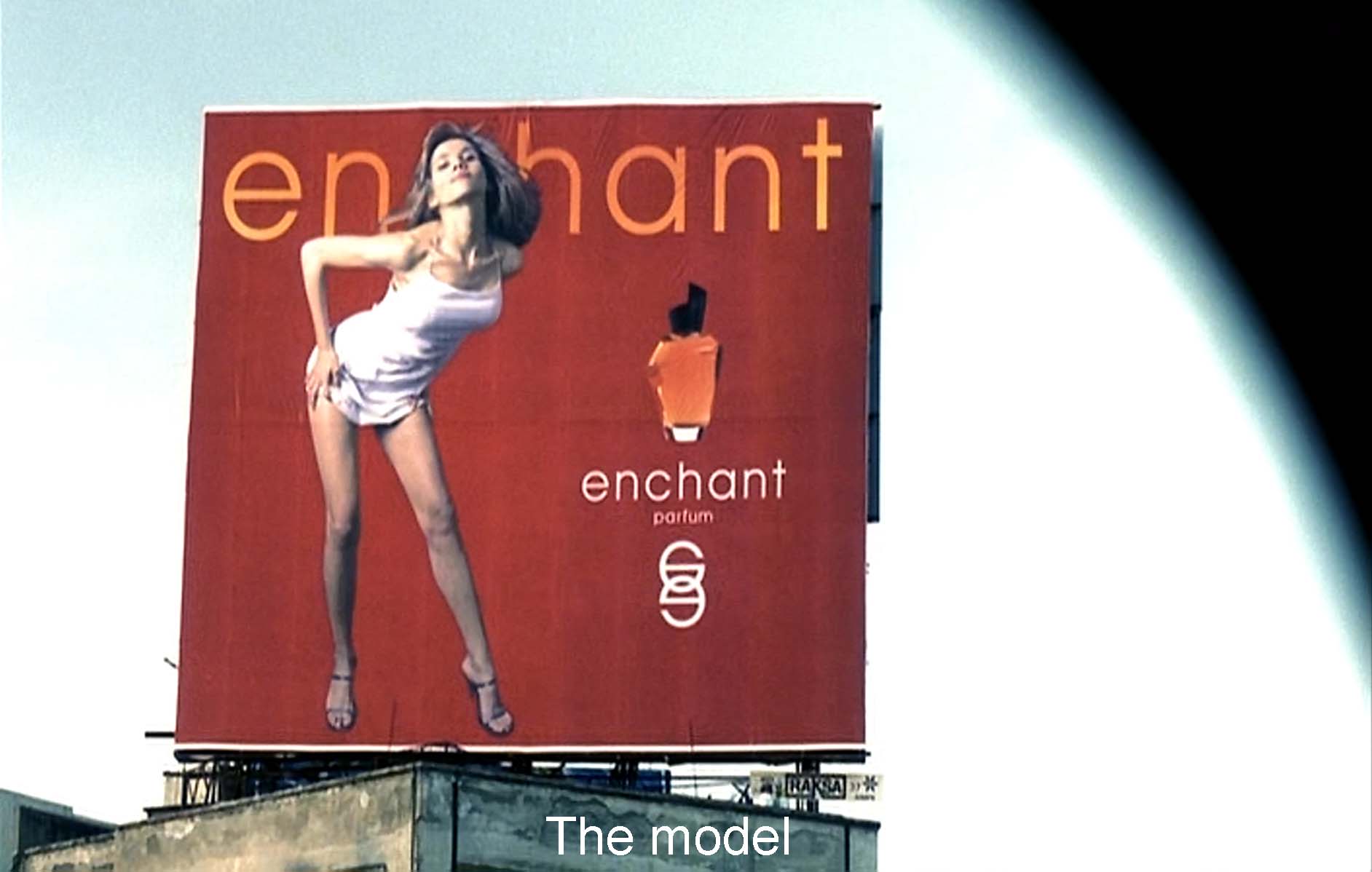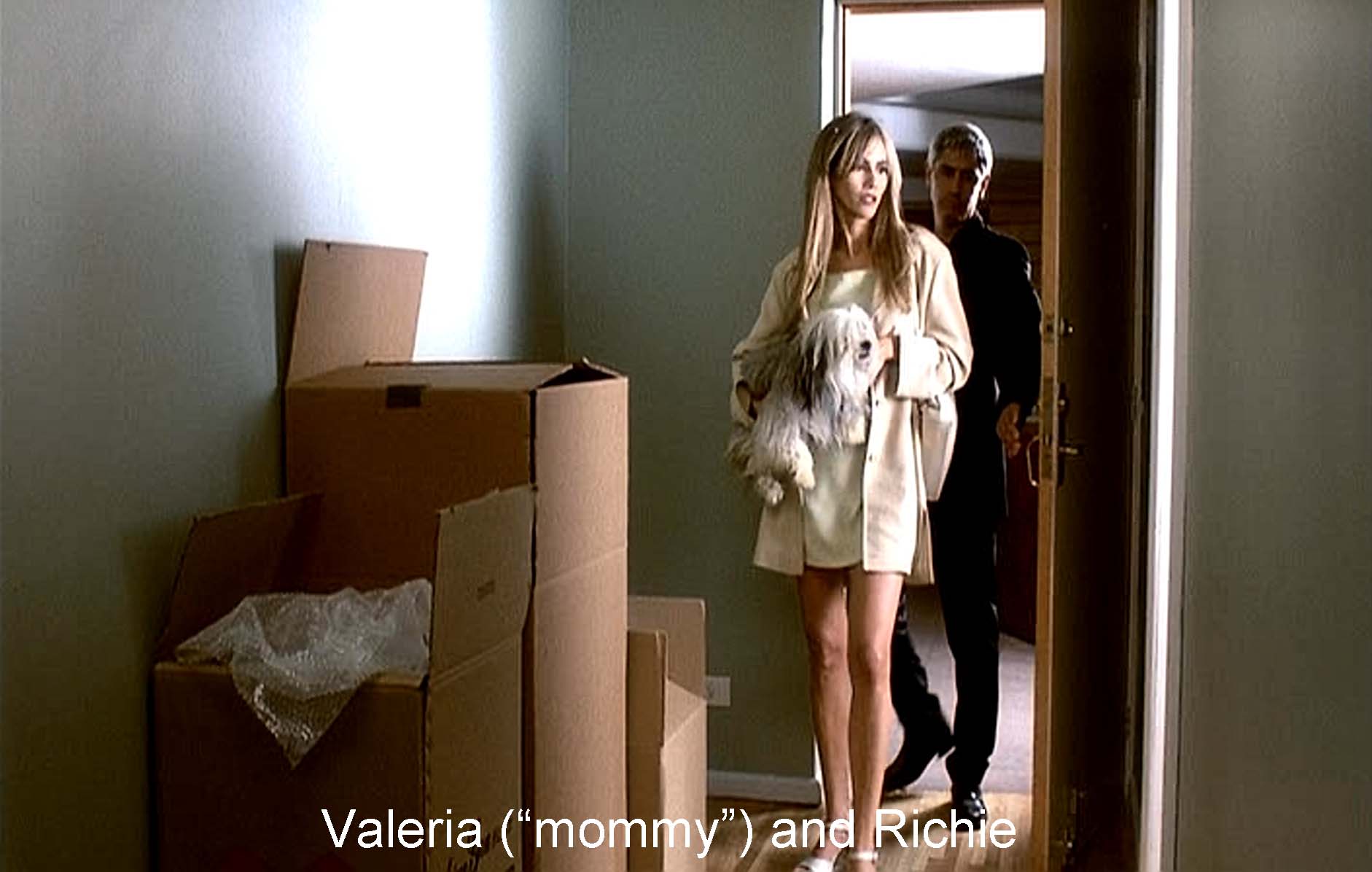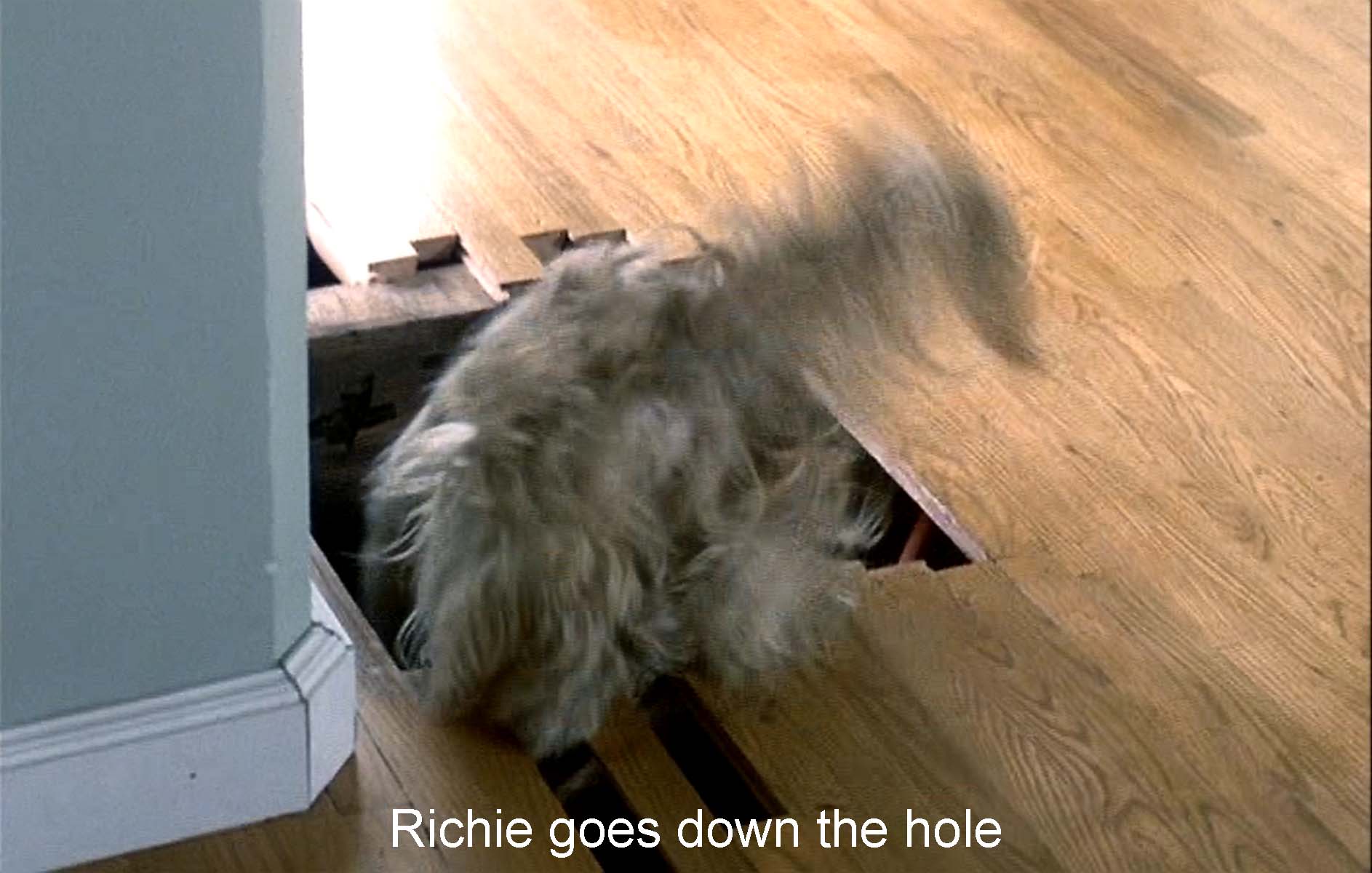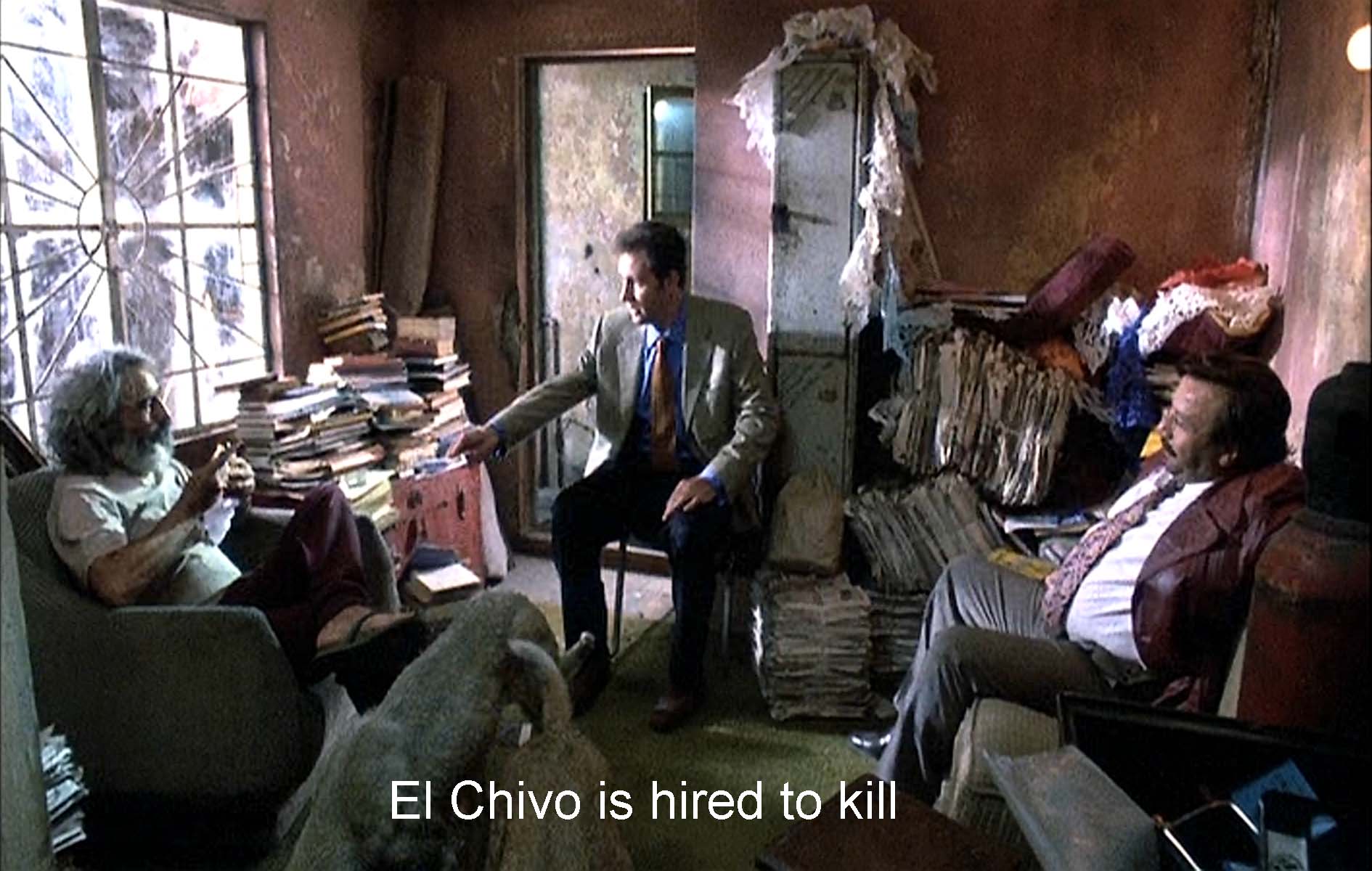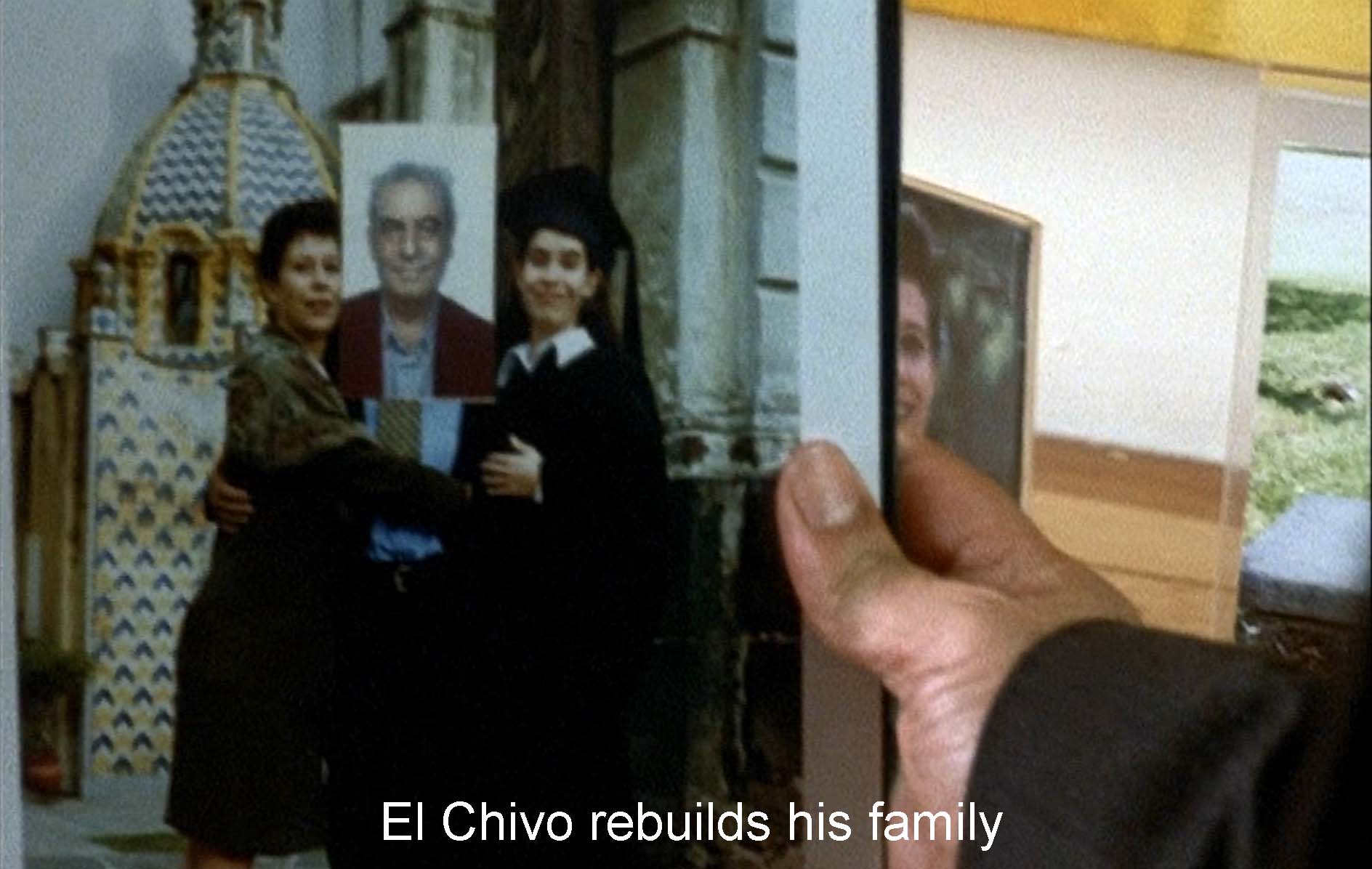Amores Perros is a city movie. Central to everything that happens in this film is life on the streets of Mexico City. That is why Iñárritu shot the whole film with hand-held cameras, no dollies, and not even tripods. The film begins with a wild car chase ending in a horrendous crash which locks three stories together.
The first story takes place around a household where a mother lives with her two sons and the wife and child of one of those sons and a dog, Cofi. Ramiro (Marco Pérez) is the older son, who brutalizes both his wife Susana (Vanessa Bauche) and the younger son, Octavio (Gael García Bernal). Ramiro works as a checker in a supermarket, but he makes his real living holding up drugstores. When Cofi kills the fighting dog of a nasty gang leader, Octavio gets drawn into the illegal world of dogfighting. He makes a lot of money and tries to get his brother’s wife to run away with him. (As if to tell us the grotesque hopelessness of this love, Octavio watches the old Lon Chaney Hunchback of Notre Dame on his tv.)
The second plot deals with Daniel (lvaro Guerrero), who leaves his wife and two daughters for an incredibly glamorous supermodel, Valeria (Goya Toledo), whose sexy picture is on billboards all around town. They set up housekeeping in a gorgeous apartment where she fawns on her beloved dog Richie, to whom she is “mommy.” Richie dives down through a hole in the floorboards and doesn’t come out and doesn’t come out. The crash leaves her with a badly broken leg that eventually has to be amputated because she keeps walking on the leg, trying to get Richie out. End of modeling career and down come the sexy pictures.
The third plot deals with El Chivo or “the goat” (Emilio Echevarría), a derelict who wheels his cart around the city trailed by his four dogs. Years ago El Chivo had abandoned his family to become a guerrilla and “set the world right and share it with” the daughter whom he abandoned for that noble purpose. Having served twenty years in prison, he now makes his living as a hired killer with a corrupt cop as his go-between. After one killing, he draws glasses on a picture of his victim to make him look like his own earlier self; he is killing his former bourgeois self. In this plot he is hired by one brother to kill his half-brother (another pair of brothers who hate each other). El Chivo witnesses the crash, steals Octavio’s money, and rescues Octavio’s dog Cofi who has been shot.
(If you’d like a more detailed synopsis, with spoilers, you’ll find it at http://tinyurl.com/65s9b5u [thanks to the International Movie Database]).
All three plots end with the main character alone and desolated. Octavio waits in vain at the bus station for Susana. Valeria stares bitterly as the billboard where her picture used to be. And El Chivo sets out with Cofi across a black wasteland, criss-crossed with a network like the complicated interconnections in this film and, I would say, in life.
All three plots deal with love, but always a failed love. Susana refuses to run off with Octavio. Valeria, it turns out, loves her dog more than her new lover, Daniel. And El Chivo cannot connect with the daughter he has longed for for so many years. All three plots deal with a failed family. In the latter two, the family fails because the father deserts, while the father in the first is a brute.
Iñárritu and his cinematographer, Rodrigo Prieto, used different styles for the three plots. The Octavio plot relies heavily on extreme close-ups in which a single face or even a part of a face fills the screen. Valeria is mostly photographed in the middle distance where most tv shows are photographed. And the filmmakers used, inevitably, a lot of long shots for the El Chivo plot as he prowls the city and looks for his daughter and his victims from a distance. Iñárritu and Prieto also chose different film stocks for the different plots, a bluer film for the Octavio and El Chivo plots and a warmer tone for Valeria. As for the crucial car crash, Iñárritu staged it only once, but he used nine cameras.
What strikes me about this film is the way the three plots get mixed into one another. Critics speak of the “penetrations” or “intersections” of the stories. You’ll see El Chivo pushing his cart along as one of the dog fights breaks up. All the time you see billboards or magazine pictures of Valeria. When El Chivo goes out to kill, he passes Ramiro and Susana on the street. All the characters and all the social classes intersect on the streets in this city film.
Iñárritu is showing us that we live in a world in which every human event is somehow subtly connected to every other human event. The great Polish director Krzysztof Kieslowski uses intersections this way to suggest a divine presence behind the web of individual human events. He creates a religious effect. Iñárritu is also religious. (He began filming this picture with a group prayer.) But when he uses the effect, I think he suggests a world of randomness. Things just happen. People just happen to be at the same time and place or within sight of one another. There is no divine plan except the frustration of our human longings. As Susana says, “If you want to make God laugh, tell him your plans.”
Because of the tangled time scheme and the intersections of plots, viewers and reviewers report that they are intensely aware in this film that they are watching a movie. Amores Perros is one of a host of postmodern films that scramble time so that, as David Denby puts it, “We know that a film is not a piece of life; we know that it is something made.” Quentin Tarantino’s Pulp Fiction (1994) probably had the most influence, but we could go way back to Alain Resnais’ Hiroshima, Mon Amour (1959) or Muriel (1963). After this film came Christopher Nolan’s Memento (2001) or Michel Gondry’s Eternal Sunshine of the Spotless Mind (2004) or Paul Haggis’s multi-Oscared Crash (2004), quite like Amores Perros.
The time scheme of Amores Perros, though, isn’t scrambled. Iñárritu and his screenwriter and close collaborator Guillermo Arriaga have enmeshed these three plots, but they fit neatly into a past, present, future scheme. The Octavio story takes place mostly in the past, before the crash. The Valeria story straddles the time of the crash. It takes place in, so to speak, the present. The El Chivo story comes mostly after the crash and looks towards a bleak, networked future in its last shot.
What’s Iñárritu’s point? Even if families disconnect and so fail, people are connected on the street, in the city. And then there are people’s connections with their dogs.
The dogs spell out the human characters’ situations. Octavio’s dog Cofi fights in the dog-eat-dog, survival-of-the-fittest world of the poor, dog and master both driven to criminal activity to survive. Cofi’s devotion to Octavio matches Octavio’s devotion to Susana.
Valeria’s dog Richie is indeed rich. Richie is unnaturally fluffed up just as his “mommy” is. Valeria is built more along Scandinavian or North American lines than, say, Susana, who looks more traditionally Mexican. Richie is pampered and indulged like her, like everyone at the top of this very unequal and unfair society. In a highly symbolic act, Richie goes under the floorboards. It becomes clear that he is the one Valeria really loves, not Daniel, but that fact has to be kept under. He gets under the floor after she has the accident. The dog rejects his damaged mistress as Daniel will do.
El Chivo’s foundlings are mangy, scrounging wanderers like himself. But he feeds them, takes care of them, plays the father to them (as he would like to do with his daughter). When he adopts Cofi, that killer dog teaches him what it means to kill. His plot is the only one that involves redemption. Symbolically, he does not want to “see blurry” anymore, he puts on his discarded glasses, and he begins to try to restore his life.
Traditionally, dogs are an emblem of faithfulness. (“Fido” means “I am faithful.”) Amores Perros matches other movies in which the love by and for dogs is so much better than the un-love of human society: Spike Lee’s 25h Hour (2002), Kelly Reichardt’s Wendy and Lucy (2008), but above all, Vittorio De Sica’s Umberto D. (1952). (See my essay at http://www.asharperfocus.com/umberto.html Dogs can both feel and receive unconditional, uncomplicated love, unlike people. All these dog films make nasty comments about the human race as opposed to the canine.
The crash symbolizes family crack-ups. In all three stories, fathers or would-be fathers fail. That is, Octavio loves the baby and wants to father another, but he tries to do it by taking his brother’s place. This brother and father abuses Octavio, abuses his wife, but it is he whom his mother favors. Daniel abandons his true role as a father to his daughters and becomes a pseudo-father to the dog Richie who, ultimately, annoys him as much as his daughters did. El Chivo left his family to pursue his dream of setting the world right and sharing it with his daughter. Now, over twenty years later, he wants to reunite with the daughter and be a father again, but he cannot bring himself to do it. All three stories end with the chief character alone and desolated.
The first and last stories also involve brothers who try to kill each other. El Chivo, with his long white hair and beard, looks like an Old Testament God from the ceiling of the Sistine Chapel when he passes judgment on the two he calls Cain and Abel. The bad people in this film, and in others by Iñárritu, are those who break family connections—and this is true in Iñárritu's later movies.
You could say that all three plots deal with love, failed love, love that crashes like the crash that starts the film. Octavio loves Susana, but she sticks (for religious reasons, perhaps) with her brute of a husband. Valeria’s love for her dog outweighs her love for Daniel. El Chivo’s love for his daughter comes out at his former wife’s funeral and leads to a change of life. Why is he “the goat”? Perhaps he is a scapegoat; perhaps he is one who loves many dogs and many people (as a guerrilla).
I think it’s more accurate to say that the Octavio plot is about love and hate or love and violence; the Valeria plot is about love and appearances and disappearances (the dog’s, Valeria’s disappearing poster); and El Chivo’s plot is about love and death. Prompted by a murder that leads him to a funeral, he wants to return from the dead to love his daughter.
There are so many things going on in this film—what’s Iñárritu’s point? I think this is a film about different kinds of connections, casual connections, commercial connections, loving connections, broken connections, hateful and violent connections, and on and on. We humans are connected or, as the neuropsychologists say, we are biologically programmed to be social animals. Our core connections are organic, family connections within a household, even households as dysfunctional as these. But there are also business connections between partners who hate each other. And there are the random connections without feeling on the street, in a city, in accidents. And finally, there are the connections created by the brilliance of this screenwriter and this filmmaker.

